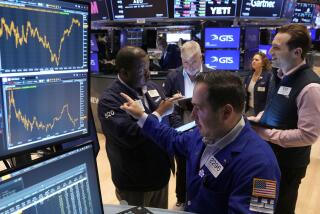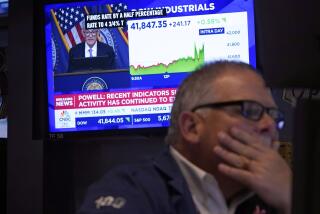CRISIS AND RECOVERY ON WALL STREET : Fed, as Expected, Injects Cash Into Financial System : Economy: The action helps to contain the stock market slide and in the process nudges interest rates down slightly.
WASHINGTON â The Federal Reserve Board, moving as promised, injected added cash into the nationâs financial system early Monday, helping to contain the stock market slide that began Friday and, in the process, nudging interest rates down slightly.
Traders said that the Fed temporarily provided about $2 billion by buying securities from banks and brokerage houses with the usual understanding that the dealers would buy them back within a week. It acted at about 8:40 a.m. PDT, about two hours after the market opened and after stock prices had begun rebounding from a further decline in the early morning.
Although the amount was not unusually large, analysts said its impact was heightened because the purchases came at a time when the Fed ordinarily would have sought to drain reserves from the banking system to offset seasonal transactions by the Treasury.
The Fedâs action appeared to be just what the markets needed. âThey promised they were going to provide liquidity, and they did,â said James Capra, a bond trader at the Shearson Lehman Bros. investment firm in New York. Capra called the move âa measured response.â
Fed Chairman Alan Greenspan, in a speech to the American Bankers Assn. here, took a low-key approach to Fridayâs market plunge.
âWe at the Federal Reserve are watching developments in the financial markets very closely,â he said. He added that âcoordination exists at a detailed levelâ between the Fed, the Treasury Department and the agencies that regulate the financial markets.
The Fed, as is its custom, did not announce its injection of cash into the financial system. But analysts were able to spot the Fedâs tracks by tracing transactions in the markets.
âThe most important thing the Fed did was psychological--that is, it reassured the market that the funds would be there,â said Scott Pardee, a former Federal Reserve official who is now co-chairman of Yamaichi International America in New York.
Traders said the timing of the Fedâs intervention appeared to signal that the central bank was easing its money and credit policies slightly in its efforts to avert a panic following Fridayâs 190-point stock-market slide.
Analysts said the Fed began injecting reserves at a point when the federal funds rate--the interest charged on overnight loans between banks--had fallen to between 8.5% and 8.6%, down about one-quarter of a percentage point from Fridayâs level of 8.75% to 8.8%.
Market specialists said the action suggested that the Fed will probably allow interest rates to remain at this new level and may even permit them to edge lower--in effect, relaxing money and credit conditions marginally.
Because the market seemed not to have panicked during the first few hours of trading Monday, traders said, the Fed apparently decided to tread lightly and keep some of its powder dry in case the slide resumed later in the week.
âThe fact that stocks were trading on the firm side today made them feel they didnât have to come in very early or very fast,â one analyst said. âThey did not want to make it look like an emergency operation.â
Edward Guay, chief economist for Cigna Corp. in Hartford, Conn., a long-time observer of Federal Reserve actions, called the Fedâs move on Monday âa gentle nudge toward an easier posture.â
Guay said the central bank apparently had come through on its promise over the weekend to inject cash into the financial system if it were needed to ward off another slide, âbut they did not want it construed as a move toward an easing in monetary policy.â
While Fed policy-makers âwant to maintain economic growth, they donât want a new spurt of inflation or a surge of speculation,â Guay said. âAll in all, itâs a rather gentle move on their part.â
At the same time, the Fedâs performance stood in sharp contrast to that of Black Monday--Oct. 19, 1987. Then the central bank did not act until Tuesday, the day after the 508-point crash and two trading days after a preliminary 108-point decline.
Many analysts said later that the Fedâs late entry then--combined with conflicting signals that the central bank issued then concerning likely interest-rate changes--resulted in a larger slide than might have otherwise occurred.
But this time, the Fed was in early, before the market had a chance to plummet 500 points or more, and deftly, so as not to upset its long-standing goal of leaning against prevailing inflationary pressures in the economy.
After the stock market closed with the Dow Jones industrial average up 88.12 points, Roger Kubarych, manager of Henry Kaufman & Co., a Wall Street consulting firm, said the Fed had turned in âa very balanced, good performance.â
But Kubarych noted that the bond market fell Monday and the currency market zig-zagged throughout the day. âThereâs going to be a lot of volatility in all these markets until people get their bearings,â he said.
More to Read
Inside the business of entertainment
The Wide Shot brings you news, analysis and insights on everything from streaming wars to production â and what it all means for the future.
You may occasionally receive promotional content from the Los Angeles Times.










